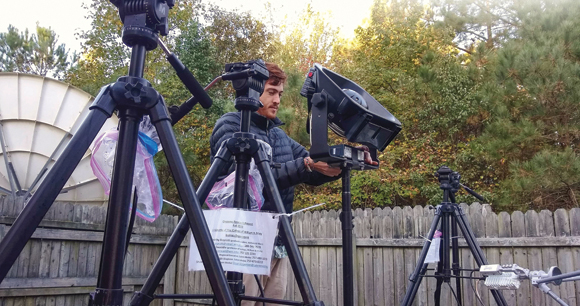by Timothy Boycott, Sally Mullis, and John Swaddle of William & Mary University and Brandon Jackson of Longwood University
Billions of birds fatally collide with human-made structures each year. These mortalities have consequences for avian population viability and the conservation of endangered species. This source of human-wildlife conflict also places economic and operational constraints on various industries. Furthermore, with continued increases in urbanization, the number and geographic extent of collisions continue to increase.

Efforts to reduce collisions have largely focused on making structures more visible to birds, such as through accessory lighting or through altering the color of the structure or its components. However, many of these methods have been only moderately successful. We investigated the efficacy of a multimodal combination of acoustic signals with visual cues to reduce avian collisions with tall structures in open airspace—what we refer to as an “acoustic lighthouse.” Based on earlier investigations, we predicted that novel acoustic cues would alter the visual attention of flying birds to make the structure more apparent and reduce the probability of collision.
In this study, partially funded with a Christine Stevens Wildlife Award from AWI, we broadcast two audible frequency ranges in front of tall communication towers in the Atlantic migratory flyway of Virginia during the annual southbound bird migration. Specifically, we compared the effects of lower-pitched (4–6 kilohertz) and higher-pitched (6–8 kilohertz) sound stimuli. These stimuli were generated from white noise filtered to their specific frequency ranges and sound similar to a fast-flowing river and loud gas leak, respectively. We employed a novel behavioral framework, implemented through three-dimensional modeling of bird flights, to assess collision risk and evaluate mitigation success. We recorded an overall 12–16 percent lower rate of bird activity surrounding towers during sound treatment conditions, compared with control (no broadcast sound) conditions.
Furthermore, when birds entered the area close to the towers, the acoustic stimuli resulted in greater deflection away from the towers and slower flight velocities. In particular, the 4–6 kHz stimulus produced the greater effects, perhaps because this frequency range is more clearly audible to the flying birds. When exposed to a 4–6 kHz sound, estimates showed that birds flew 1.5 meters per second slower and 5 meters farther away from the towers, on a heading that was farther away from the tower, relative to flights in control conditions.
Our study demonstrates that this “acoustic lighthouse” concept reduces the risk of collision for birds in the field and could be applied to reduce collision risk associated with many human-made structures—such as wind turbines and tall buildings—thereby potentially saving billions of birds annually.